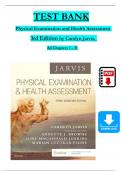Exam (elaborations)
TEST BANK For Physical Examination and Health Assessment, 3rd Edition by Carolyn Jarvis, Verified Chapters 1 - 31, Complete Newest Version
- Course
- Institution
- Book
TEST BANK For Physical Examination and Health Assessment, 3rd Edition by Carolyn Jarvis, Verified Chapters 1 - 31, Complete Newest Version TEST BANK For Physical Examination and Health Assessment, 3rd Edition by Carolyn Jarvis, Verified Chapters 1 - 31, Complete Newest Version Test Bank For Physica...
[Show more]



